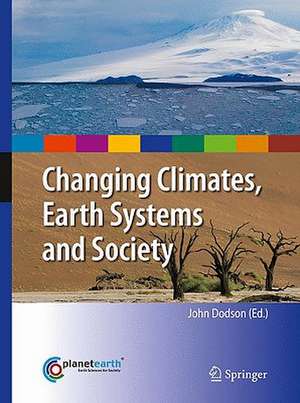Changing Climates, Earth Systems and Society: International Year of Planet Earth
Editat de John Dodsonen Limba Engleză Hardback – 23 sep 2010
Preț: 530.33 lei
Preț vechi: 576.45 lei
-8% Nou
Puncte Express: 795
Preț estimativ în valută:
101.50€ • 105.79$ • 84.50£
101.50€ • 105.79$ • 84.50£
Carte indisponibilă temporar
Doresc să fiu notificat când acest titlu va fi disponibil:
Se trimite...
Preluare comenzi: 021 569.72.76
Specificații
ISBN-13: 9789048187157
ISBN-10: 904818715X
Pagini: 300
Ilustrații: XX, 244 p.
Dimensiuni: 193 x 260 x 20 mm
Greutate: 0.7 kg
Ediția:2010
Editura: SPRINGER NETHERLANDS
Colecția Springer
Seria International Year of Planet Earth
Locul publicării:Dordrecht, Netherlands
ISBN-10: 904818715X
Pagini: 300
Ilustrații: XX, 244 p.
Dimensiuni: 193 x 260 x 20 mm
Greutate: 0.7 kg
Ediția:2010
Editura: SPRINGER NETHERLANDS
Colecția Springer
Seria International Year of Planet Earth
Locul publicării:Dordrecht, Netherlands
Public țintă
ResearchCuprins
Setting the Scene: How Do We Get to a Fitting Future?.- Impacts of Climate Change on Terrestrial Ecosystems and Adaptation Measures for Natural Resource Management.- Fire in the Earth System.- Vanishing Polar Ice Sheets.- Climate and Peatlands.- Climate and Lacustrine Ecosystems.- Rivers.- Climate Change and Desertification with Special Reference to the Cases in China.- Climate Change, Societal Transitions and Changing Infectious Disease Burdens.- Don’t We All Want Good Weather and Cheap Food?.- Building Capacity to Cope with Climate Change in the Least Developed Countries.- Climate Change Mitigation Policy: An Overview of Opportunities and Challenges.
Recenzii
From the reviews:
“Editor Dodson (Australian Nuclear Science and Technology Organisation) and 37 authors from 13 countries do a good job covering the issues. … The book covers past and future changes in terrestrial ecosystems, peatlands, polar ice, and lake and river water resources. … The material is written clearly enough for most people to comprehend, and the scientific papers and the extensive references should satisfy those with technical backgrounds. Summing Up: Highly recommended. Lower-division undergraduates and above.” (M. K. Cleaveland, Choice, Vol. 48 (7), March, 2011)
“Editor Dodson (Australian Nuclear Science and Technology Organisation) and 37 authors from 13 countries do a good job covering the issues. … The book covers past and future changes in terrestrial ecosystems, peatlands, polar ice, and lake and river water resources. … The material is written clearly enough for most people to comprehend, and the scientific papers and the extensive references should satisfy those with technical backgrounds. Summing Up: Highly recommended. Lower-division undergraduates and above.” (M. K. Cleaveland, Choice, Vol. 48 (7), March, 2011)
Textul de pe ultima copertă
The book covers state-of-the-art considerations on how climate change has and will deliver impacts on major globalised biophysical and societal themes that will affect the way the world functions.
Human activity has resulted in changes to atmospheric chemistry and land cover, and caused serious decline in biodiversity. Modifying biogeochemical cycles leads to complex feedbacks. The future climate will have impact on food security and agriculture, water supply and quality, storm and cyclone frequency, shoreline stability, biodiversity and the future of biological resources. Earth scientists might be asked to forecast any potential abrupt or environmental surprises. A sound knowledge of the Earth System will improve the chances of achieving this, by developing climate models that will reduce the degree of uncertainty in regional climate prediction.
This volume sets out a framework of research issues that show how the Earth sciences contribute to a better understanding of climate change and suggests where future research will best contribute to the wellbeing of society. The key topics discussed are:
- climate change patterns over the last four glacial cycles;
- the variability in climate over the last 1000 years;
- impact that past climate change has had on societies;
- the role of human activities in climate forcing;
- the role of models in predicting future climate and how we can assess their merit;
- the future and likely future climate trajectories.
Human activity has resulted in changes to atmospheric chemistry and land cover, and caused serious decline in biodiversity. Modifying biogeochemical cycles leads to complex feedbacks. The future climate will have impact on food security and agriculture, water supply and quality, storm and cyclone frequency, shoreline stability, biodiversity and the future of biological resources. Earth scientists might be asked to forecast any potential abrupt or environmental surprises. A sound knowledge of the Earth System will improve the chances of achieving this, by developing climate models that will reduce the degree of uncertainty in regional climate prediction.
This volume sets out a framework of research issues that show how the Earth sciences contribute to a better understanding of climate change and suggests where future research will best contribute to the wellbeing of society. The key topics discussed are:
- climate change patterns over the last four glacial cycles;
- the variability in climate over the last 1000 years;
- impact that past climate change has had on societies;
- the role of human activities in climate forcing;
- the role of models in predicting future climate and how we can assess their merit;
- the future and likely future climate trajectories.
Caracteristici
State-of-the-art analysis of climate change impacts on societal relevant themes Expert authorities discuss relationship of climate with each theme Valuable reference for policy and decision makers








